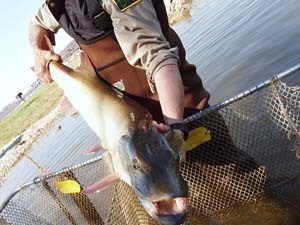|
March 16, 2017
Contact: Brian Gunderman, 269-685-6851, ext. 145 or Sara Thomas, 248-666-7443
DNR will move muskellunge this spring in effort to build inland broodstock sources

The Michigan Department of Natural Resources continues to make advancements in the state's Great Lakes muskellunge program, and activities this spring will add to those efforts.
Since 2011, the DNR’s Fisheries Division has collected spawning Great Lakes strain muskellunge in the Detroit River. The collected eggs are reared at Wolf Lake State Fish Hatchery in Mattawan and stocked throughout the state in fall. Although the Detroit River is a natural source of this native strain, it presents several challenges.
Water temperatures on the Detroit River typically do not reach optimal levels for spawning until late May or early June, much later than smaller inland waterbodies. This results in a short rearing period and fish not reaching maximum size for stocking each fall. Additionally, the Detroit River’s expansiveness makes it extremely difficult to efficiently find spawning fish.
To offset these issues, DNR fisheries staff have been working to establish inland broodstock lakes. Since 2011, Thornapple Lake in Barry County has been stocked with Great Lakes strain muskellunge to establish a population large enough to provide a spawning population. Starting in 2017, Lake Hudson, previously the long-standing broodsource for northern strain muskellunge, was selected as the department’s second broodstock lake. When the populations are large enough, spawning fish will be netted from these inland lakes rather than the Detroit River.
Because Lake Hudson and Thornapple Lake previously were both maintained as northern strain muskellunge broodstock lakes, the density of this species is higher than typical populations across Michigan. In order to reduce the numbers of competing predators in these waterbodies and to provide the best opportunity for the Great Lakes strain to succeed, DNR Fisheries Division will conduct trap and transfers this spring targeting the northern strain muskellunge.
Fish captured through these activities will be relocated to waters selected with the following criteria: absent of viable outlets to prevent escapement, suitable forage for adult muskellunge, not currently stocked with muskellunge (plus the two previous criteria) or have pre-existing northern strain muskellunge populations.
Northern muskellunge from both Thornapple Lake and Lake Hudson have undergone disease testing to ensure fish diseases will not be transferred to any of the recipient waters.
Up to 100 northern strain muskellunge will be captured in Thornapple Lake and transferred to Lower Crooked Lake (Barry County), which has a small muskellunge population remaining from stocking in the early 2000s. Up to 20 additional fish may be stocked into Long Lake (St. Joseph County) to supplement an existing muskellunge fishery. In addition, although northern pike will not be targeted during this effort, those captured will be transferred to areas downstream of Thornapple River dams located in Irving and Middleville. Northern pike can compete with muskellunge for food, and adult northern pike are potential predators of newly stocked muskellunge.
Up to 150 northern strain muskellunge will be captured from Lake Hudson and transferred to Orchard Lake (Oakland County). Orchard Lake is 850 acres located in a densely populated area. Although this will be a one-time stocking event, it should generate angler interest and excitement in an area currently lacking muskellunge fishing opportunities.
Following the transfer, muskellunge fishing opportunities on both Thornapple Lake and Lake Hudson should continue to be excellent due to their initial high densities. As the Great Lakes strain fish grow, they will provide even more exciting chances to hook a muskellunge.
In the future, fish reared as part of the DNR’s Great Lakes strain muskellunge program will be stocked in Thornapple Lake and Lake Hudson as fall fingerlings or spring yearlings. Muskellunge generally are stocked in the fall, but Michigan and other states are experimenting with stocking of spring yearlings in an effort to increase survival of the Great Lakes strain fish.
For more information on how the DNR rears Great Lakes muskellunge, check out this story.
/Editor's note: An accompanying photo is available below for download. A suggested caption follows.
The DNR is preparing to transfer northern strain muskellunge from two Michigan lakes to other destinations in an effort to enhance its Great Lakes muskellunge program./
The Michigan Department of Natural Resources is committed to the conservation, protection, management, use and enjoyment of the state’s natural and cultural resources for current and future generations. For more information, go to www.michigan.gov/dnr.
|







